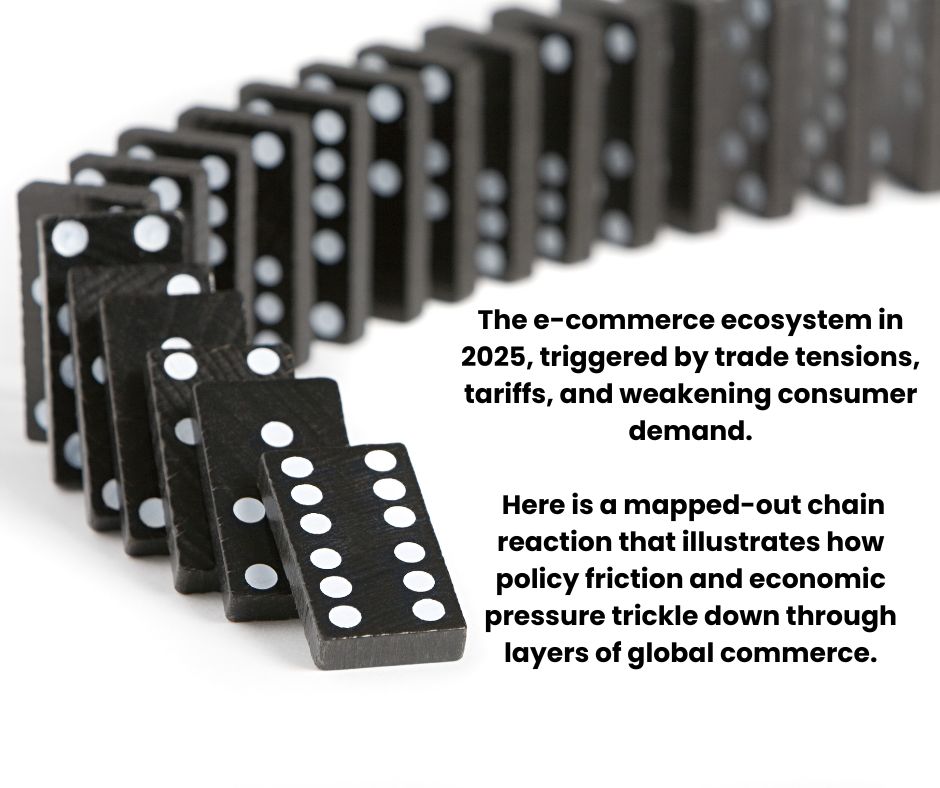The Real Trickle-Down Economics: A 2025 Case Study of E-Commerce Slowdown

Forget Reagan’s version of trickle-down economics, which claimed that tax cuts for the wealthy would eventually benefit everyone. In today’s hyperconnected global economy, we’re witnessing a different — and far more immediate — form of real trickle-down: where disruption at the top of a supply chain causes cascading damage across industries, labour markets, and financial systems.
One stark example: the e-commerce ecosystem in 2025, triggered by trade tensions, tariffs, and weakening consumer demand. Below is a mapped-out chain reaction that illustrates how policy friction and economic pressure trickle down through layers of global commerce.
Step-by-Step Trickle-Down Impact of a Slowdown in E-Commerce
1. Manufacturing & Supply Chain Disruption
Trigger: U.S. tariffs rise to as high as 145% on Chinese goods.
Stat: Chinese e-commerce exports to the U.S. fell by 65% in Q1 2025 (The Guardian).
Effect:
· U.S. sellers face higher costs or cannot access stock.
· Chinese manufacturers cancel or delay shipments, hurting factory output.
· Alternatives like Vietnam or India can't yet scale up to meet demand.
2. Online Retailers & Marketplaces
Stat: Amazon has closed or delayed dozens of fulfillment centres, including 300 jobs lost in California alone (California Globe).
Effect:
· Amazon sellers go out of stock or pass costs to consumers.
· Smaller e-commerce brands exit marketplaces or cut staff.
· Consumer product variety declines and shipping delays increase.
3. Consumer Behaviour
Stat: 54% of U.S. consumers plan to reduce discretionary spending in 2025 (PayPal BRC).
Effect:
· Higher prices reduce conversion rates.
· Non-essential shopping (fashion, gadgets) plummets.
· BNPL (Buy Now, Pay Later) use declines, especially among younger shoppers.
4. Logistics & Fulfillment Disruption
Stat: Container bookings from China to the U.S. dropped by 60%; U.S. ports expect a 35% decline in arrivals (AP News).
Effect:
· Amazon, UPS, FedEx, DHL scale back operations.
· Warehouse jobs are lost; temporary staff not renewed.
· Trucking and rail shipments slow → carriers lay off drivers.
5. Financial Services & Payments Sector
Impact: PayPal and other fintechs (e.g., Stripe, Klarna) see declining transaction volume.
Stat: PayPal warns of revenue pressure as consumer transactions slow (NBC New York).
Effect:
· Fintechs tighten lending or BNPL risk exposure.
· Investor confidence dips in consumer-facing financial stocks.
· Cash flow crunch for small merchants using online processors.
6. Broader Economic Impact
Stat: U.S. GDP contracted by 0.3% in Q1 2025, the first decline in 3 years (AP News).
Employment Stat: Only 62,000 jobs added in April 2025, signalling softening labour market momentum.
Ripple Effect:
· Industrial warehouse demand falls → vacancies rise.
· Local economies near ports and hubs see business loss.
· Ad spend on platforms like Google and Meta declines as sellers cut marketing budgets.
This is trickle-down economics in action — not the 1980s version, but the real domino effect of global interdependence: tariffs in China mean layoffs in California; restraint in Ohio shrinks jobs in Texas; when Amazon trims a warehouse, fintechs, ad platforms, and dockworkers all feel it.
Conclusion: The Interdependence Economy
This isn’t a theoretical debate — this is trickle-down economics in action, but not the kind touted by 1980s policymakers. It’s the domino effect of modern interdependence: tariffs in China create layoffs in California. Consumer restraint in Ohio shrinks trucking jobs in Texas. And when Amazon trims a warehouse, the effects hit fintechs, ad platforms, and even crane operators at Long Beach.